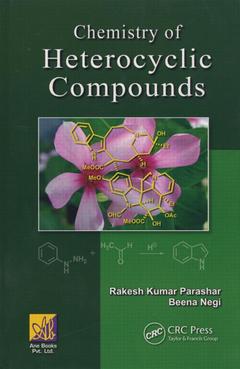Description
Chemistry of Heterocyclic Compounds
Author: Kumar Parashar Rakesh
Language: English
Subjects for Chemistry of Heterocyclic Compounds:
300 p. · 15.6x23.4 cm · Hardback
Description
/li>Contents
/li>Biography
/li>
This book discusses the structure, synthesis, and reactivity of heterocyclic compounds. It covers nomenclature, conformational aspects, aromatic stabilization and biological activity of heterocyclic compounds. The book also includes discussions of biochemical processes involving destruction of heterocyclic rings. It includes problem sets that help readers to understand and apply the principles of heterocyclic reactivity and synthesis. The inclusion of more advanced material and references make the book a valuable reference text for postgraduate taught courses, postgraduate researchers, and chemists at all levels working with heterocyclic compounds in industry, particularly in the pharmaceutical and agrochemical industries.
Introduction. Nomenclature of Heterocyclic Compounds. Three-Membered Heterocyclic Compounds with One Hetero Atom. Three-Membered Heterocyclic Compounds with Two Hetero Atoms. Four-Membered Heterocyclic Compounds with One Hetero Atom. Four-Membered Heterocyclic Compounds with Two Hetero Atoms. Five-Membered Heterocyclic Compounds with One Hetero Atom. Bicyclic Ring Systems Derived from Pyrrole, Furan and Thiophene. Five-Membered Heterocyclic Compounds with Two Hetero Atoms. Bicyclic Ring Systems Derived from pyrazole, imidazole, oxazole,isoxazole and thiazole. Six-Membered Heterocyclic Compounds with One Hetero Atom. Bicyclic Ring Systems Derived from Pyridine. Tricyclic Ring System Derived from Pyridine. Six-Membered Heterocyclic Compounds with Two Hetero Atoms. Bicyclic Ring Systems Derived from Pyridazine, pyrimidine, pyrazine. Seven-Membered Heterocyclic Compounds.
These books may interest you

Heterocyclic Chemistry, 3rd Edition 214.69 €

Marine Natural Products 369.24 €


